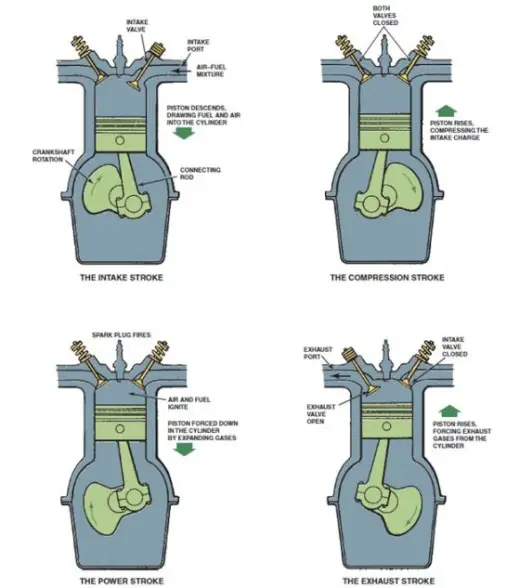Principles:
The first four-stroke cycle engine was developed by a German engineer, Nickolaus Otto, in 1876. Most automotive engines use the four-stroke cycle of events. The process begins by the starter motor rotating the engine until combustion takes place. The four-stroke cycle is repeated for each cylinder of the engine.
A piston that moves up and down, or reciprocates, in a cylinder can be seen in the following figure. The piston is attached to a crankshaft with a connecting rod. This arrangement allows the piston to reciprocate (move up and down) in the cylinder as the crankshaft rotates.
Operation:

A cycle is a complete series of events that continually repeats. Most automobile engines use a four-stroke cycle.
Engine cycles are identified by the number of piston strokes required to complete the cycle. A piston stroke is a one-way piston movement either from top to bottom or bottom to top of the cylinder. During one stroke, the crankshaft rotates 180 degrees (1/2 revolution). A cycle is a complete series of events that continually repeats. Most automobile engines use a four-stroke cycle.
- Intake stroke. The intake valve is open and the piston inside the cylinder travels downward, drawing a mixture of air and fuel into the cylinder. The crankshaft rotates 180 degrees from top dead center (TDC) to bottom dead center (BDC) and the camshaft rotates 90 degrees.
- Compression stroke. As the engine continues to rotate, the intake valve closes and the piston moves upward in the cylinder, compressing the air-fuel mixture. The crankshaft rotates 180 degrees from bottom dead center (BDC) to top dead center (TDC) and the camshaft rotates 90 degrees.
- Power stroke. When the piston gets near the top of the cylinder, the spark at the spark plug ignites the air-fuel mixture, which forces the piston downward. The crankshaft rotates 180 degrees from top dead center (TDC) to bottom dead center (BDC) and the camshaft rotates 90 degrees.
- Exhaust stroke. The engine continues to rotate, and the piston again moves upward in the cylinder. The exhaust valve opens, and the piston forces the residual burned gases out of the exhaust valve and into the exhaust manifold and exhaust system. The crankshaft rotates 180 degrees from bottom dead center (BDC) to top dead center (TDC) and the camshaft rotates 90 degrees.
This sequence repeats as the engine rotates. To stop the engine, the electricity to the ignition system is shut off by the ignition switch, which stops the spark to the spark plugs. The combustion pressure developed in the combustion chamber at the correct time will push the piston downward to rotate the crankshaft.
Next Steps towards ASE Certification
Now that you’re familiar with the Four Stroke Cycle of Combustion Engines, try out our free Automotive Service Excellence Tests to see how much you know! Test your knowledge of automotive engines in order to Ace the A1 – Engine Repair or A8 – Engine Performance exams!
![ASE Certification Training HQ - Free ASE Practice Tests [Updated 2021]](https://asecertificationtraining.com/wp-content/themes/simplefolio/images/ASE Certification Logo.png)
